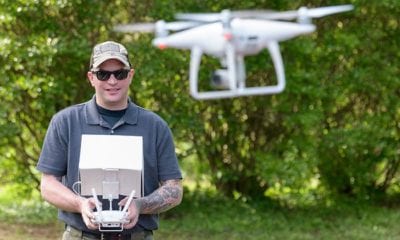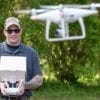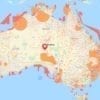
News
Security Implications of Drones in Airspace
The use of civilian unmanned aerial vehicles (UAVs) or drones has created a new threat to air traffic. We have already seen many cases of UAVs flying too close to manned aircraft, such as commercial and military flights as reported in many countries. These incidents seem to happen very often which brings the need for conducting a multi-vector analysis of the matter.
Two authors at the Wydawnictwo Naukowe Akademii (Academy of Science) in Poland decided to address this manner and trigger the lack of law regulations as well as people’s lack of understanding of the threat.
As the abstract of this paper reads:
“Unidentified drones have already landed within area of nuclear power stations, military units and even highly secured interior of the White House. So, the challenge is rather significant. It could lead to undermining the security of air traffic, but at the same time to terrorists’ attacks, the violation of privacy, and sabotage, including acts against critical infrastructure. It is necessary to study the issue and the paper could be a contribution to enhancing the understanding of the challenge and facilitator of further research.”
Selected Security Aspects of the Use of Drones
The authors state that currently, it is not so easy to fully predict what purposes drones could be used for in the future. The society sees them as unmanned platforms that can be used by armed forces or national law enforcement services and enhance their capabilities of creating a safe and secure environment
However, we should not forget the fact that drones not only support security – they are also a real threat for overall security systems.
“Unmanned solutions are linked with some “systemic gaps” and they could become challenging for security and it is not only linked with terrorism. As a result, technological development within the sphere of unmanned solutions must be closely interconnected with accelerating research, also in such fields like law, teleinformatics systems, crisis management, defence and security including internal security of each single nation.”
The aviation regulations, according to the authors, distinguish a few categories for drones according to their weight or impact kinetic energy. As such, they are quite a challenge to the security of airspace – and government actions are more than needed to address the integration of all the drones within the airspace, especially in the US.
Legal Aspects of Regulating the Use of Drones
According to the Polish law (since the authors are Polish), there is no clear and unambiguous definition of an unmanned aerial vehicle – as well as a general lack of precise description of such devices. A typical term that is used to describe these UAVs is “drone” – which is still generally used in a variety of jargons.
The authors also touch the fact that nowadays, there are plenty of services that utilize commercial drones, which is why it is necessary to consider what to do with other drone users who declare non-commercial uses as it is not easy to verify such declarations.
“In Poland, similarly to other countries, many intrusions into airport controlled zones have been noticed and in consequence, dangerous attempts to get as close as possible to a manned aircraft. Many accidents have not been published by media to avoid panic and a threat of using an air mode of travelling,” the authors noted.
The authors also propose a framework that will include the very popular FPV flights which are the most exciting for pilots, as operated only in designated zones.
Conclusion
The general conclusion of the authors touches the fact that more UAVs for private and commercial purposes are being used – and this is an issue that needs to be properly faced by agencies responsible for air traffic.
“New technologies offer more advanced solutions and now a drone or UAV is available for an average person to be used for a variety of purposes. The desire to limit their use is not to be successful, requiring rather the creation of tools to ‘civilize’ and legalize those emerging capabilities. Air accidents involving UAVs require decisive and purposeful steps to merge that group of airspace users into an overall system. If it does not happen, more accidents will happen, especially among the radical elements of societies having new ‘tools’ to play with. It should not even be excluded that UAVs will be armed by amateur “pilots” to conduct air combat and attack ground targets similar to military UCAVs. ”
The authors also state that the desire to challenge manned aircraft could be unavoidable, and with the further development of this industry, certain law regulations must come to action – especially ones that pertain to both small and large size flying platforms.
Citation: K. Załęski, Z. Śliwa, “Selected security aspects of UAVS utilization in airspace,” Security Forum, vol. 1, no. Volume 1 No. 1/2017, pp. 85–97, 2017. http://cejsh.icm.edu.pl/cejsh/element/bwmeta1.element.desklight-b336068d-b8a9-4480-a752-ad82b7b7d1d9























